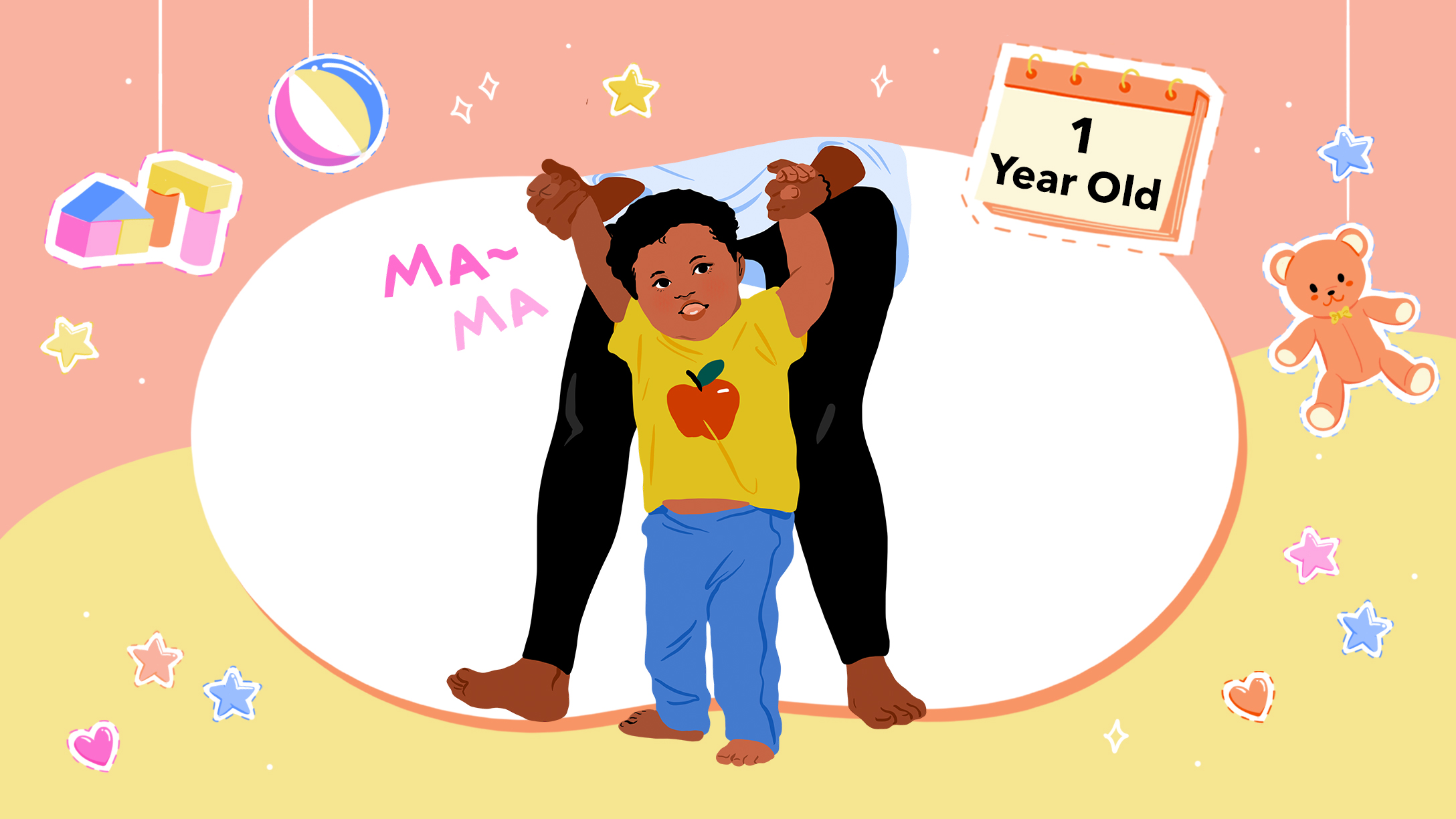
Have a box of tissues handy — it’s totally normal to have mixed feelings about the one-year mark. Maybe you feel some relief that your family is sleeping well and has a sense of routine again, or maybe there’s a little feeling of mourning at the close of this baby chapter. All these reactions are very valid. Don’t worry, though. There’s so much fun coming in the next year as your baby starts to express themself in new ways and your relationship deepens even more. Year two is very rewarding — we’re excited for you!
Your 1-Year-Old’s Milestones
It’s hard to imagine that your blobby baby is now a 1-year-old! They can say some words like “mama” and “dada,” or “uh-oh.” Get ready for a word explosion in the next year. Your baby might have taken their first steps already, or they may still rely on your hands or any available furniture to help.
They constantly test your responses to their actions — how are you going to respond when they throw their food on the floor? Or if they cry? Or if they pull open that drawer and take everything out? Your baby is trying to figure out how you and their world work.
Your 1-year-old might be fearful in some situations, have clear favorites in people and toys, and likely still cry if you or their caregiver leaves the room. They’re little scientists, consistently trying to figure out if objects or toys behave the same way every time they drop it, throw it, chew it, shake it, or squeeze it.
Some other 1-year-old milestones, according to the American Academy of Pediatrics (AAP), include:
- Gets into a sitting position without assistance.
- Crawls or creeps forward.
- Pulls up into a standing position, cruises, or takes independent steps.
- Uses a pincer grasp.
- Bangs two objects together, inserts or removes objects from containers, and lets objects go from their hands voluntarily.
- Responds to simple verbal requests or “no.”
- Imitates speech and babbles with intention.
- Imitates gestures.
- Begins to use objects correctly.
Your 1-Year-Old’s Development
According to the World Health Organization (WHO), the average baby weight and height for a 1-year-old is 19.6 pounds and 29.1 inches for girls and 21.2 pounds and 29.8 inches for boys. Your baby has likely tripled their birth weight as well as grown an additional 10 inches. Don’t worry if your child hasn’t grown to these exact numbers. Remember there is a wide range of normal for children, and your child is fine as long as they are growing and developing.
If there’s anything about your baby’s behavior that concerns you, please contact your child’s pediatrician. According to the AAP and the Centers for Disease Control and Prevention (CDC), some signs of developmental delay in your 1-year-old could be:
- Doesn’t crawl or drags one side of the body while crawling for longer than a month.
- Cannot stand when supported.
- Doesn’t say single words like “mama” or “dada.”
- Doesn’t use gestures, such as waving or shaking their head.
- Doesn’t search for objects you hide while they watch.
- Doesn’t point to things.
- Loses skills they had before.
Note: If you are visiting a medical professional during COVID, make sure to ask about the facility’s safety measures and confirm that they are following COVID protocols as indicated by the Centers for Disease Control and Prevention (CDC).
A General Schedule for Your 1-Year-Old
Since your 1-year-old is awake so much longer and is much more alert, it can feel as if you have to entertain your baby the entire day — which is mentally and physically exhausting. While there are definitely fun activities you can do at home or in your neighborhood, know that you don’t really need to do anything special. Have your child join you or stick by you as you exercise or run errands. Give them their own child-friendly book as you read your own for a few minutes. Be comfortable with letting your baby make a mess and explore the world safely without your constant intervention.
Here is one suggested routine:
- Morning: feed, play, snack, nap
- Afternoon: feed, play, nap, feed, play
- Evening: feed, play, bath (not necessarily daily), story or lullaby
- Night: feed, sleep
Feeding and Eating Guidelines
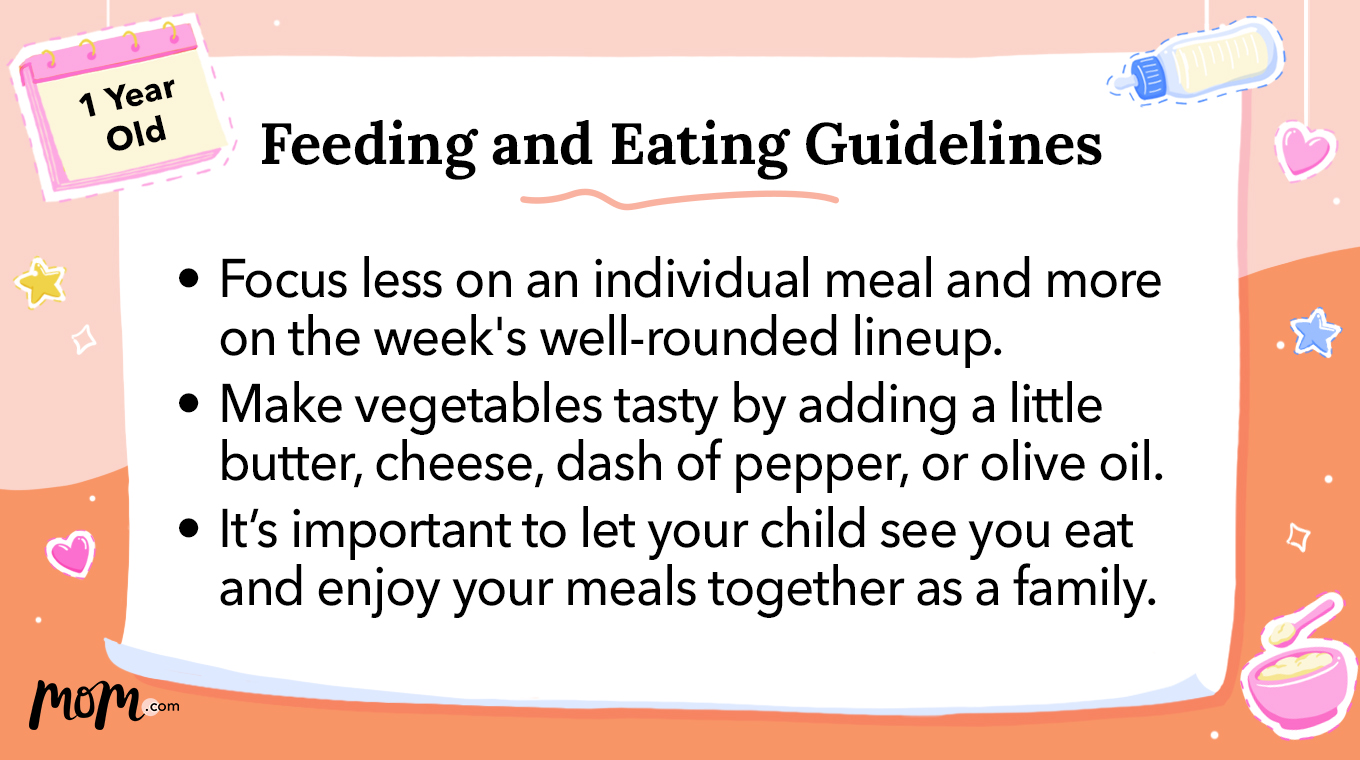
If you haven’t already, and you’re formula-feeding, talk to your pediatrician about introducing cow’s milk, or another form of milk. If you’re breastfeeding, there’s no need to add any other milk to the equation. You can continue to nurse through the upcoming year and beyond without cow’s milk. Just make sure to protect those breastfeeding sessions and your resulting milk supply.
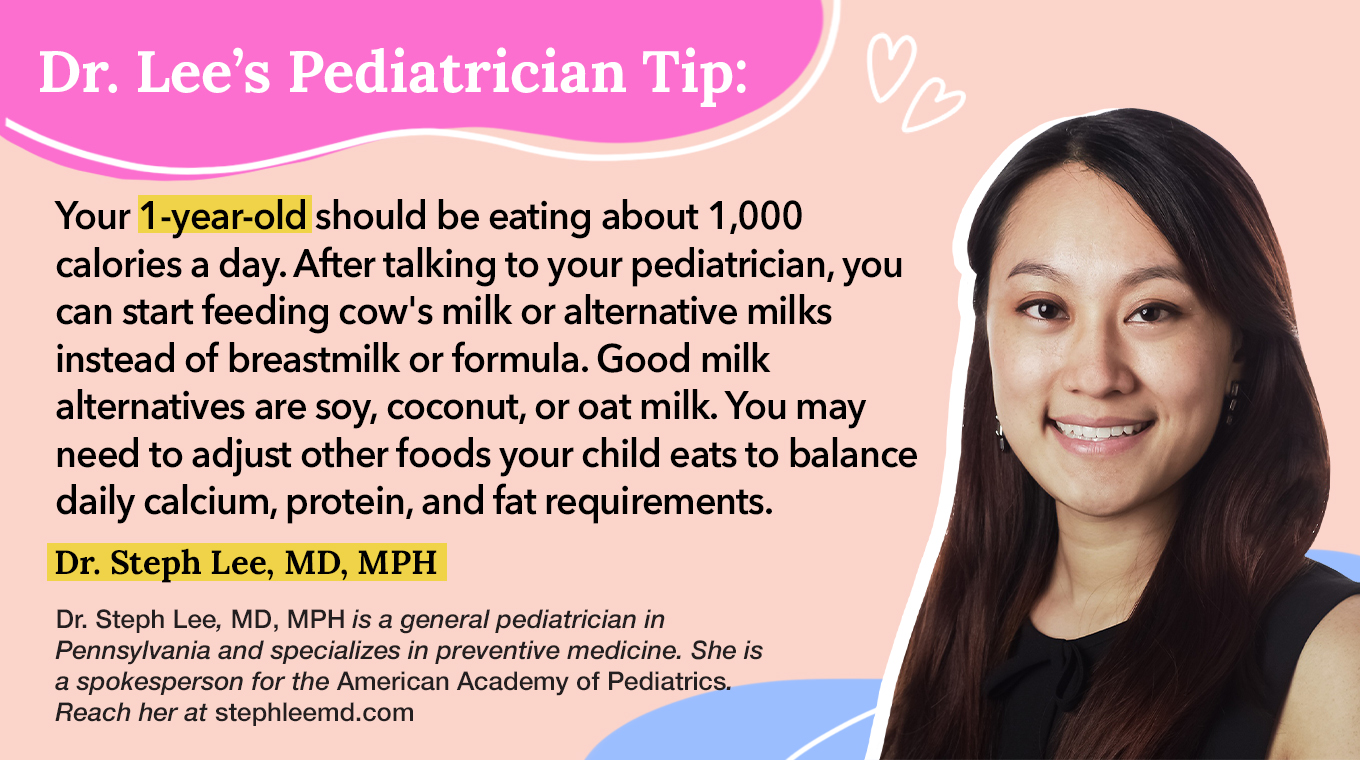
Here’s a great rule of thumb for toddler feeding schedules:
Parents are in charge of what, when, and where to eat, and kids are in charge of deciding whether and how much to eat.
It will come as no surprise to learn that toddlers eat more some days and less on others. Try to focus less on an individual meal and more on the week’s well-rounded lineup.
To nurture a veggie lover, don’t be afraid to make vegetables tasty. There’s no need for plain steamed vegetables every day, so add a little butter, cheese, a dash of pepper, or olive oil. Make stir-fry or curries or soups. If you can get vegetables at the farmers market, fresh veggies are often tastier.
“Do not underestimate the power of the family meal. Set a good example,” says Cynthia Epps, a board-certified infant feeding specialist. Let your toddler see you eat and enjoy your meals together as a family. If you’re the only family member present, always sit down and eat with your child, even if you only are eating a little bit, Epps says. This prevents a one-way dynamic where your child feels pressured into eating. By providing consistent mealtimes, your toddler sees you eat and enjoy a wide variety of foods. With your help as a model, hand-to-mouth coordination will continue to improve.
Play: Toys, Games, and Activities
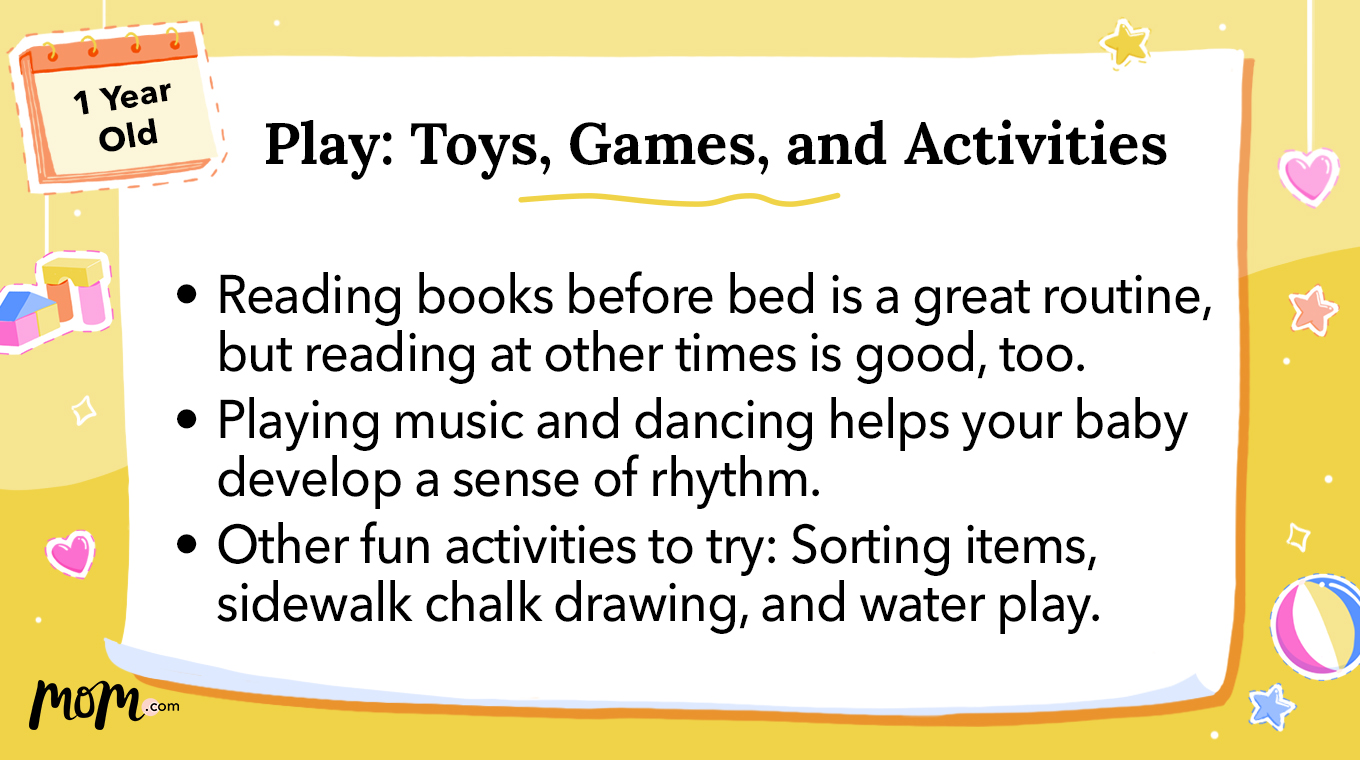
Kung – Korbkarn Limsombatanan
Think beyond bedtime when it comes to reading. A great routine is reading books before bed, but reading at other times of the day is also a good pattern to get into. Have a small stack of books in the living room and your room, too. If your baby wakes up nice and early and you don’t have to start your day right away, make reading a morning routine. When you read, expand on ideas and words with your baby, make hand gestures to accompany books, and use a sing-song voice or other engaging tone to keep their attention. Most babies love reading and, as they grow, it encourages imagination and language development.
Music also has a wonderful and far-reaching impact on your baby’s brain. Playing music and dancing helps your baby develop a sense of rhythm, so break out the tunes once a day and have a dance party. The more you clap, bounce, sing, and dance, the more your baby learns timing and beats, as well as body coordination and many other developmental skills.
For other fun activities, you can try:
- Paint their hands and feet, and stamp card stock, construction paper, whatever you want! (Make sure you keep a few for the memories.)
- Practice sorting different items (e.g., cotton balls, beans, flowers) using muffin tins, empty egg cartons, different bowls or cups, or a sectional plate.
- Give your baby some sidewalk chalk, and let them have at it outside.
- Fill a tub or bucket with water, and give your baby different items to throw in the bucket to see if the items float or sink.
Sleep and Nap Guidelines
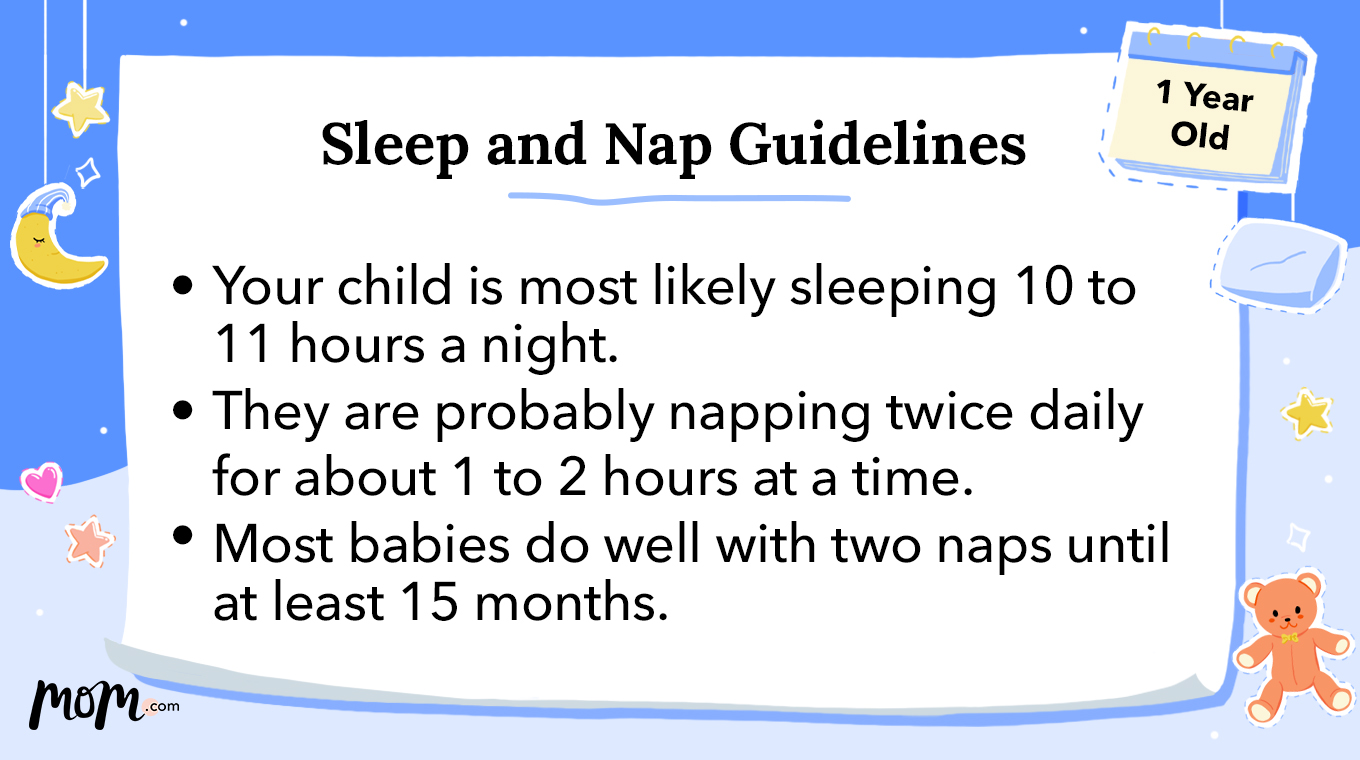
Kung – Korbkarn Limsombatanan
Your 1-year-old is most likely sleeping 10 to 11 hours a night and napping twice daily for about one to two hours at a time. If your baby has consolidated down to one nap, it should be a roughly three-hour stretch. Most babies do well with two naps until at least 15 months, but if you’re wondering whether your baby is ready to drop a nap, here are the signs you might look for, according to The Happy Sleeper author and sleep consultant Heather Turgeon:
- Baby sleeps at least 11 hours at night.
- Baby is resisting taking one of their two naps for at least two weeks straight.
- One nap is becoming very short.
- The second nap is starting to interfere with bedtime.
A sample sleep schedule for a 1-year-old:
- Wake time: 6:45 a.m.
- Nap 1: 9:30 a.m.
- Nap 2: 2:30 p.m.
- Bedtime: 7:00 p.m.
Common 1-year-Old Health Conditions
In addition to the one-year checkup, get the flu vaccine for your little one. Because COVID-19 and the flu have similar symptoms, the AAP and the CDC recommend everyone 6 months or older (without medical contraindications) get the current age-appropriate influenza vaccine to help conserve potentially scarce medical resources. The flu vaccine will not protect your 1-year-old from possibly contracting COVID-19. Please consult your child’s pediatrician to see whether your baby needs two doses of vaccine or only one dose.
When your baby is 12 months old, there is usually a 1-year-old checkup appointment with your child’s pediatrician. Depending on the dosing schedule and type of vaccination, they may receive the AAP- and CDC-recommended third doses of the following immunizations:
- Hepatitis B (HepB)
- Poliovirus (IPV)
They may also receive the third or fourth doses of the following immunizations:
- Haemophilus influenzae type b (Hib)
- Pneumococcal conjugate (PCV13)
They may also receive the first doses of the following immunizations:
- Measles, mumps, rubella (MMR)
- Varicella (VAR)
They may also receive the second dose of the following immunization:
- Hepatitis A (HepA)
Congratulations!
That’s it, you made it! Your once-tiny baby is now a thriving personality-filled toddler, thanks to you. Congrats!







